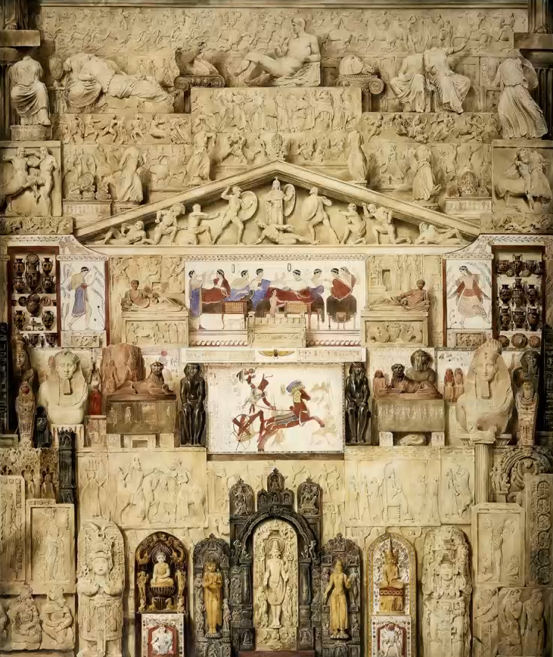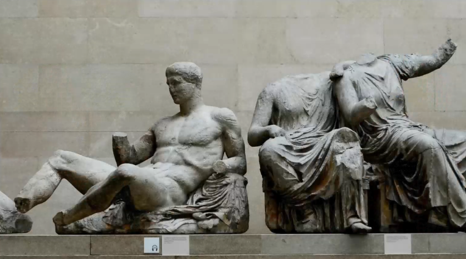Lecture 1: The Tyranny of Antiquity
1/6
There's no tags or description
Looks like no tags are added yet.
Name | Mastery | Learn | Test | Matching | Spaced |
|---|
No study sessions yet.
7 Terms
Key Lecture Takeaways
Classical norms/canons of taste are difficult to fully displace from Art History
Classical art, for all its associations with purity, can be used for a variety of purposes, means, & agendas (we need to grapple w/ its afterlife)

An Assemblage of Works of Art, from the Earliest Period to the Time of Phydias, James Stephanoff (1945)
Provenance
Watercolour
Made around the time when the Parthenon marbles were installed in the British Museum (BM)
Description
Apex: Parthenon Marbles
Immediately below: other objects brought to the BM during this period (e.g. other marbles, parts of the Nereid Monument)
Middle: Egyptian art, Persian reliefs
Below: art of Central America, Indonesian art, Indian art
Interpretation
Shows art from around the world, but only select cultures are featured (e.g. China, Japan, Africa excluded)
Depending on Britain’s interest in select cultures at the time
Visual hierarchy of classical perfection, according to the artist’s own imagined conception (NOT how they were actually displayed)
Aesthetic hierarchy dressed up as a chronological progression
The cult of antiquity also involves a degree of fantasy & fabrication
Was seen as a source of epistemological truth/knowledge
Useful guide/diagram to be compared & referenced
Presents the superiority of the Parthenon Marbles as a universal truth, fixed & indisputable
A historical phenomenon rather than an aesthetic judgement

East Pediment, Parthenon Marbles (447-432 BCE), British Museum London
Provenance
From the temple of Athena (the Parthenon) on the Acropolis in Athens
Carved by Phidius
Ancient Greek sculptor, painter, & architect (hailed as superior)
Removed by Thomas Bruce (Lord Elgin) between 1801-1815, brought to Britain
People initially didn’t know it was by Phidias, believed it to be 2nd-rate (Roman copy)
Rugged form
For a while, Elgin struggled to sell them
Only sold to the nation in 1816
A select committee was held by the House of Commons inquiring into the acquisition of the sculptures (on whether it was worth spending public money on them)
Artists were on the committee, viewed as figures of authority w/ exclusive aesthetic knowledge
Rising social status of the artist
Description
A collection of different types of marble architectural decoration (incl. friezes in relief)
Reading List
Aris Sarafinos, ‘BR Haydon and Racial Science’
Cora Gilroy-Ware, ‘Antonio Canova and the Whatever Body’
Darcy Grimaldo Grisby, ‘Nudity a là grecque in 1799’
Aris Sarafianos, ‘BR Haydon and Racial Science’
Benjamin Robert Haydon
Artist & critic
Early 19th century Britain (1800s)
Background
Engaged in debates about race & art
‘Negro Faculties’ debate in The Examiner
Leigh Hunt wrote an editorial praising an African-American businessman, Paul Cuffee
Tied racial polygenism to artistic & scientific methods
Intgrated anatomical science into art
E.g. cited Petrus Camper
Dutch anatomist
Made charts mapping the angles of jawlines
E.g. used Apollo Belvedere at one end of the spectrum, and a monkey on the other
Intention: to make a value-free set of bodies
BUT his bodies were co-opted by racists to prove that white people are superior to black people
Consequences
Haydon (& artists in general) gained cultural capital
Modernised & legitimised the profession
Formulated a new way of making sense of the body
Demonstrated the cultural mobility of racial discourse
Cora Gilroy-Ware, ‘Antonio Canova and the Whatever Body’
Antonio Canova (1757 – 1822)
18th-19th centuries
An Italian Neoclassical sculptor (and lesser-known painter) famous for his marble sculptures
Historical Context
Evolution of ideal beauty
Ancient Greece: designed to perfect nature
17th & 18th century Europe: tied to moral teachings; encouraged virtuous behaviour
Late 18th-early 19th centuries (Canova’s time): lost its moral meaning; a blank canvas for fantasies; the female form as newly central
Key Arguments
Canova as a transitional figure whose work connects the classical world w/ postmodern visual culture
Paintings depicted classical figures w/ elongated & stylised forms; idealised beyond traditional proportions
Philosopher Giorgio Agamben: the ‘whatever body’
A body detached from prescribed/fixed meaning
In contemporary fashion imagery: bodies idealised & edited for commercial appeal; constantly updated & consumed anew
Darcy Grimaldo Grigsby, ‘Nudity à la grecque in 1799’
Intervention of the Sabines (1799) by Jacques-Louis David
Provenance
Made after the end of the Directory period (1795-1799)
After the crisis of the Terror
Divided society
Rise in feminist activism
Description
Depicts a legendary episode following the abduction of the Sabine women by the founding generation of Rome
Sabine women: daughters of the Sabines, wives of the Romans
Roman & Sabine men fighting while the Sabine women intervene
Controversy
Female dress vs. Male nudity
Classical style of male nudity was rooted in ancient ideals: ideal form
BUT was seen by some as alien to French habits & values
Stripped one of class authority (for the bourgeoisie: nudity = shameful; for the working class: rendered the ruling class vulnerable to ridicule of bourgeois pretensions)
Women’s intervention & men’s friezelike status
Sabine women as mediators in a fractured society
BUT may still reinforce traditional gender roles for women
Still bound to the roles of mothers & wives
Underscores the complexities of using classical art to navigate changing cultural, political, & social landscapes in revolutionary France.